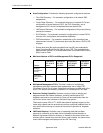
1. About the FrameSaver SLV
9128-A2-GB20-80 September 2002
1-11
OpenLane SLM System
Being standards-based, the OpenLane SLM (Service Level Management) system
can be used with other management applications like HP OpenView or IBM’s
NetView. OpenLane includes HP OpenView adapters for integrating OpenLane
features with the OpenView Web interface.
Being Web-based, the OpenLane system provides Web access to the data
contained in the database to provide anytime, anywhere access to this information
via a Web browser.
Some of the OpenLane system’s features include:
Real-time performance graphs provide exact performance measurement
details (not averages, which can skew performance results) of service level
agreement (SLA) parameters.
Port bursting and EIR (Excess Information Rate) performance monitoring
graphs are available when the software release for the OpenLane SLM system
is Release 5.2, or later.
Historical SLV graphs provide service level management historical reports so
frame relay SLAs can be verified.
Diagnostic troubleshooting provides an easy-to-use tool for performing tests,
which include end-to-end, PVC loopback, connectivity, and physical interface
tests.
For units with ISDN backup capability, provides ISDN physical interface and
PVC testing when the software release for the OpenLane SLM system is
Release 5.2, or later.
Basic configuration allows you to configure FrameSaver devices. Network
DLCI Circuit IDs can also be assigned.
Automatic SLV device and PVC discovery allows all SLV devices with their SLV
Delivery Ratio configuration option enabled to be discovered automatically,
along with their PVCs.
A FrameSaver unit can be reset from the OpenLane system.
Firmware downloading provides an easy-to-use tool for downloading to an
entire network or a portion of the network.
On-demand polling of FrameSaver devices, and SNMP polling and reporting
are available.
The maintenance scheduling feature allows for the scheduling of multiple
periodic maintenance periods, and provides a record of all scheduled
maintenance periods – past, present, and future.


















